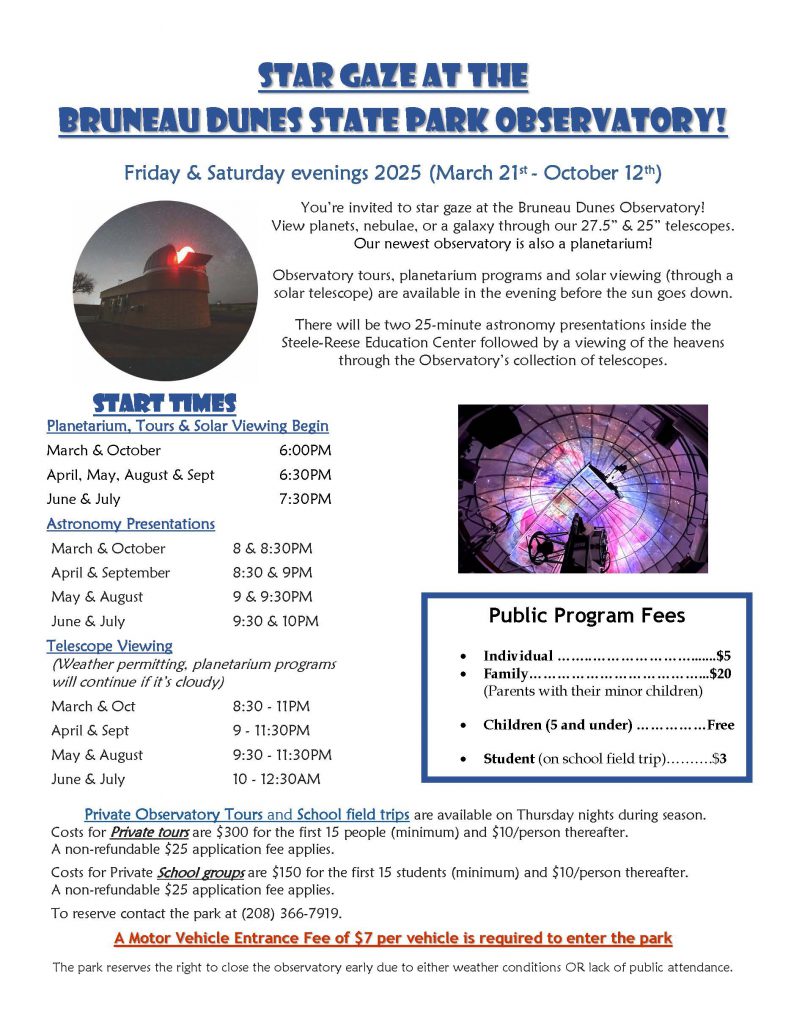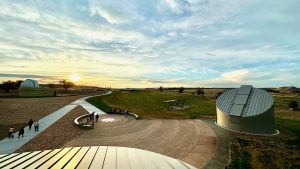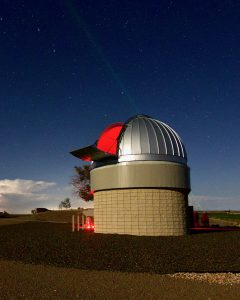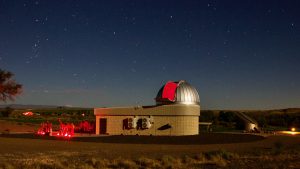Bruneau Dunes State Park is home to one of Idaho’s largest and most capable telescopes. The new, state-of-the-art observatory features a rotating dome protecting the powerful telescope and provides an unobstructed view of the night sky. There are opportunities for the public to enjoy presentations and telescope viewing. Start your evening with a tour and solar viewing before sunset, then see an astronomy presentation and view the telescopes. There are fees for the after-sunset options which includes a planetarium experience..
Please note: The park reserves the right to close the observatory early due to weather or lack of attendance. A Motor Vehicle Entrance Fee of $7 per vehicle is required to enter Bruneau Dunes State Park.
On this page
2025 Public Observatory Schedule and Hours
The Observatory is open to the public on Fridays and Saturday evenings, March 21 through October 12. Please refer to the following schedule which changes based on month and sunset times.
Observatory tours and solar viewing (through a specially adapted telescope) begin one hour before sunset and are free of cost. Following that, visitors can enjoy a short orientation program before experiencing the observatory’s collection of telescopes.
Before Sunset Tours and Solar Viewing
March and October: 6 p.m.
April, May, August, and Sept: 6:30 p.m.
June and July: 7:30 p.m.
Free
Main Program Schedule and Admission
Entrance fees include a presentation, telescope viewing, the planetarium show, tours of both observatories and viewing through the telescopes. The price is the same to attend one or all of the events.
Telescope Viewing
March and October: 8:30 p.m. to 11 p.m.
April and Sept: 9 p.m. to 11:30 p.m.
May and August: 9:30 p.m. to 11:30 p.m.
June and July: 10 p.m. to 12 a.m.
Astronomy Presentations
Enjoy a 25-minute astronomy presentation at the Steele-Reese Education Center, followed by telescope viewing through the Observatory’s telescope collection. Presentations have a limited seating of 80 people per presentation.
March and October: 8 p.m. and 8:30 p.m.
April and September: 8:30 p.m. and 9 p.m.
May and August: 9 p.m. and 9:30 p.m.
June and July: 9:30 p.m. and 10 p.m.
Admission Fees
Individual $5
Family $20 (Parents with their minor children)
Children (5 and under) Free
Student (on school field trip) $3

Idaho Department of Parks and Recreation has identified the resource of our beautiful dark skies as a treasure to be protected. Many of our Parks and Natural spaces in Idaho are striving to increase awareness of the dangers of light pollution, reduce their impact on the night sky environment, and obtain Dark Sky certifications where appropriate through the International Dark-Sky Association. Please visit www.darksky.org for more information on this initiative and how you can make an impact!
What is light pollution?
Inappropriate or excessive use of artificial light.
Why is light pollution having a negative effect on Idaho?
- Plants and animals depend on daily light cycles to sustain life preserving behaviors, such as migratory patterns and feeding cycles, artificial light at night has negative and even deadly effects on many wildlife species.
- Nighttime viewing of astronomy is severely inhibited by “Sky glow,” a phenomenon produced by large emissions of artificial light at night. Additionally, your natural night vision is briefly inhibited by white artificial light.
- Many Americans sleep in an environment that’s punctuated with some form of artificial light, whether it comes from an intrusive streetlight, outdoor camper lighting, or flashlights. New research suggests that one night of sleep with just a moderate amount of light may have adverse effects on cardiovascular and metabolic health.
Steps you can take to preserve the night sky while enjoying your stay at any Idaho State Campground:
- Swap outdoor lighting on your camper for an amber lensed fixture.
- Change out high admitting bulbs to bulbs emitting under 500 lumens.
- Make efforts to direct fixtures toward the ground and apply shields preventing vertical light emission.
- Keep all lighting targeted in the direction it is needed and avoid unnecessary artificial light at night whenever possible.
Current weather conditions at the observatory.
Observatory Info
In 1998 our first observatory was dedicated in cooperation with the Boise Astronomical Society. They chose this site because of its limited light pollution. The 25” Obsession reflecting telescope was donated by BAS, and has provided amazing views to thousands of visitors each year. In 2023 a second observatory was built, housing a Planewave CDK700 telescope that provides imaging and remote use capabilities. The dome of the new observatory is also used as a planetarium, providing programs during the day and on cloudy nights.





